Are you a lacrosse player or fan looking to learn more about what are the different positions in lacrosse? Then you've come to the right place!
We have gathered experts from the field and created this comprehensive guide. It has everything you need to know about positions - their responsibilities, advantages and disadvantages, skills sets they require, and more.
Discover an all-inclusive explanation of every position on the field with us today!
More...
Take Away Key Points:
If you don't know how to choose the best lacrosse position, this comprehensive guide to the 4 main lacrosse positions (and three additional ones) will solve your dilemmas.
Read below for more information.
What Are Lacrosse Positions?
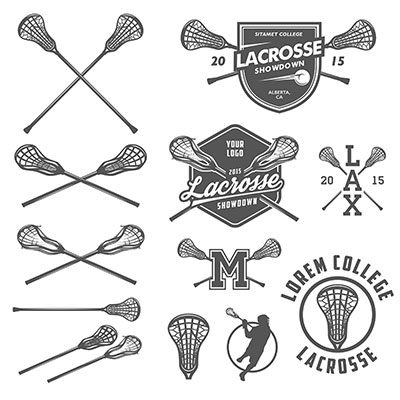
Lacrosse is an ancient team sport with exciting and diverse positions to choose from. A lacrosse team consists of ten players in different lacrosse positions. The four main positions are the following: attackmen, midfielders, defenders, and lacrosse goalies.
- Attackmen are the primary offensive players responsible for creating offensive opportunities by passing and shooting the ball into the goal.
- Midfielders are responsible for both offense and defense, providing support in all field areas by controlling possession of the ball and covering opponents on defense.
- Defenders also focus on stopping opponents from scoring while transitioning the ball upfield with swift passing or great defense sticks to set up attacking opportunities.
- Finally, goalies are essential in guarding their net against incoming shots by opponents and communicating defensive tactics to prevent visits to their net.
In addition to these four main positions, three specialized positions have been created in recent years:
1. face-off specialist (who specializes in taking face-offs),
2. long-stick midfielder (who specializes in defending midfielders), and
3. short-stick defensive midfielder (who specializes in helping defenders).
These specialist positions have become more common in today's lacrosse games, helping teams mix up their strategies on both sides of the field.
We will explain each of the lacrosse positions below.
1. Lacrosse attackers
The primary job of men's field lacrosse offensive players is to score goals and establish control over the play. The lacrosse attack position is located closest to the goal on the lacrosse field.
They use a short stick with a narrow head to pass, catch, scoop and shoot the ball past defenders. The stick's handle is shorter than other positions to provide better accuracy for shots.
There are three attackers located on the offensive side of the lacrosse field. These players have the best stick skills for scoring goals and ensuring victory for their lacrosse team.
Protective equipment such as padded gloves, shoulder pads, helmets with face masks, and leg/arm pads are worn by attacking players for maximum safety. The contact is allowed within five yards of the crease area near both sides of the net on offense and defense. Attacking lacrosse positions need more protection since they often engage in physical play with defenders in this area.
In addition to playing offensive roles like taking shots and creating space by faking out opponents and changing directions, the attackers are also responsible for helping out on loose balls upfield.
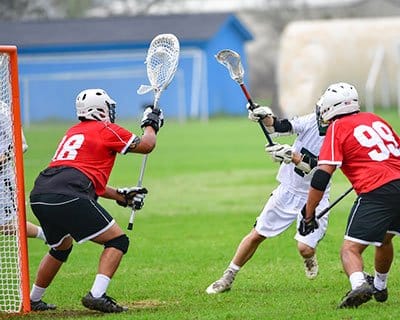
There are three different spots for the attacking lacrosse players on the field:
1. X attackman - X refers to the area behind the goal. Their job is to get past the defender for a pass or a shoot. These players are the best dodgers on a team.
2. Wing attackmen - these players line up in a wider position away and out of the goal. These attackmen are good shooters or doggers.
3. Crease attackmen - they move without the ball and line up close to the goal. The wing or X attackers look for their crease-open teammates for a quick "slam dunk" type of shot.
However, besides creating more scoring opportunities, all players on the offensive side of the field have the main responsibility called riding. They must prevent the opposing team from bringing the lacrosse ball down the field.
2. Lacrosse midfielders
Midfielders/midfield line is a vital part of the game, responsible for controlling the action on both defense and offense.
On the field, midfielders use specialized sticks that have a shallow pocket, an arched head, and a scooped face to help them cradle and pass the ball more effectively. In terms of equipment, in addition to their stick, lacrosse midfielders typically wear helmets with full-face masks, elbow pads, and hand protectors.
There are usually three midfielders on a team at one time. The three midfielders transition from one half of the field to another based on possession and strategic shifts during play. They can play both offense and defense to help other team members.
An offensive midfielder is adept at passing to attackers, dodging defenders, and penetrating with smart cutting. Defensive midfielders work hard to create turnovers and cover opposing attackers to slow down play on the defensive end.
Another responsibility midfielders have is to run in short shifts and substitute in and out often, similar to a hockey game. Midfielders take many shots on the run, so their feet move while shooting.
In addition, midfielders play in transition parts and have to bring the ball from the defensive side to the offensive half of the field.
With their varied responsibilities and essential contributions on both sides of the field, it's no wonder why these three players are such an integral part of any team's success.
3. Lacrosse defenders/D-pole lacrosse position
Lacrosse defenders provide the necessary protection around the offensive zone, allowing attackers to get into an excellent position to score. Their main job is to stop the offensive players from scoring the ball.
There are three players on the defensive side of the field, in the defense line, protecting goals and helping goalies guard the critical half of the field.
Three defensemen use a long stick, unlike attackers or midfielders, and the long stick is known as a d-pole. The long stick measures 72 inches and has longer and deeper pockets. Thus, the lacrosse stick helps them contain their opponents' sticks while also being able to reach out to intercept passes.
Protective gear such as helmets, chest pads, gloves, and arm pads ensure that the defenders can take on any challenge presented by the attacker.
Defenders must work together even when they're not carrying possession of the ball. They must position themselves strategically so that their opponents cannot penetrate their side of the field too easily. It is an essential aspect of lacrosse that requires dedication, skill, and determination from all players involved for it to succeed.
The three players communicate the most on the lacrosse field, more than any other lacrosse players, to stop shots and help their goalie from being attacked. The audience can hear them often from the sideline.
In addition to protecting the defensive zone, the three defenders are also responsible for clearing the ball from the defensive zone. The attacking lacrosse players ride on the balls, while those playing defense must safely intercept and clear the possession.
4. Lacrosse goalie
Lacrosse goalies play an essential role in the game. Their position is deep inside the goal area, in the last line. A lacrosse goalie is stopping shots from the opposing team, catching or blocking each one that comes their way. Those shots are more than 100 mph, so the goalie must be more than focused on the ball.
A goalie is equipped with a traditional lacrosse stick with an especially wide head, making them particularly effective at cradling the ball and clearing it away quickly. To protect him/her from contact with other players, a lacrosse goalie also wears specialized gear, including chest protectors, arm and shoulder pads, throat guards, helmets, and padded gloves.
Especially adept at anticipating incoming passes and balls, a good goalie quickly moves around within their goal area. The goalie also looks for the best possible opportunity to make a successful save so their team can keep ownership of the ball. This is their primary purpose in the game.
In addition, the goalie plays the captain, as he/she keeps the entire team at the respected positions and calls for the defensive players to show where the other lacrosse players are to find the best strategies for the lacrosse play.
Finally, the lacrosse goalie performs clearing of the ball from the defensive half of the field to the offensive half. Sometimes, lacrosse goalies must perform accurate and long passes to clear the ball successfully.
5. FOGOs - Face off, get off lacrosse positions
FOGOs are one of three specific additional lacrosse positions. The main objective of these players is to win the face-off that happens after each goal and at the start of every quarter.
The two players are fighting for the possession of the ball, like in basketball or hockey. Like attackmen, these players must have sharp and advanced stick skills to gain possession quickly in favor of their team.
The lacrosse position is relatively new, developing in the last ten years. The FOGO player stays in the offensive zone after the face-off, but they mostly leave the game to make room for an offensive midfielder.
If a FOGO player loses possession in favor of the opposing team, they play defense until their team substitutes defensive midfielders.
6. LSMs - Long stick midfielders
A long stick midfielder is a lacrosse position using an extra long stick, similar to a defender, but he can move everywhere on the field, like midfielders.
These players have an easy time when they play defense, and there are four players with the extra long stick on the field at once. Teams use long-stick midfielders in defensive situations.
The long-stick midfielder's main purpose is to guard the best midfielder from the opposing team. Another purpose of the long stick midfielder is to fight for the ball possession during the face-off or play the wing and fight for the ground ball.
7. SSDMs - Short stick midfielders
A short-stick defensive midfielder is a player designated to play defense only. The short stick midfielder is positioned on the defensive half, with the primary purpose of playing defense, instead of offense and defense. Lacrosse teams substitute the players to match the short-stick midfielder from the opposing team.
The short-stick midfielders come out when the ball is in the offensive zone and help clear the ball with the other defenders. As lacrosse has become more popular and specialized, the players in these positions also gained more recognition.
What Are the Positions of the Opposing Team?
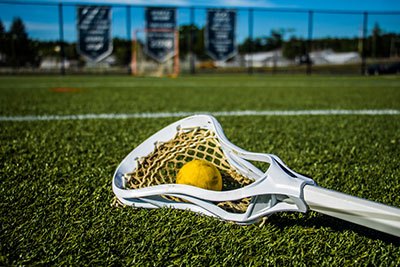
As lacrosse needs two teams, the opposing team also features ten players with the same lacrosse positions as their counterparts. So you can find:
- three opposing attackmen
- three opposing defensemen
- three opposing midfielders, and
- one opposing goalie in the primary lacrosse positions.
However, the opponents also offer the opposing FOGOs, short-stick and long-stick midfielders in the extra positions. All these players face each other during the match, and their positions also match fair play and given standards.
What Are the Positions in Women's Lacrosse?
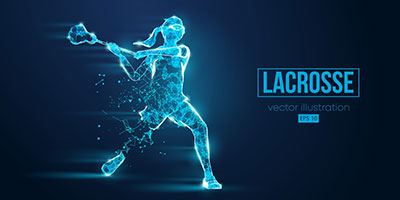
Women's lacrosse offers slightly different positions. You can find them below:
Lacrosse Transitions Explained
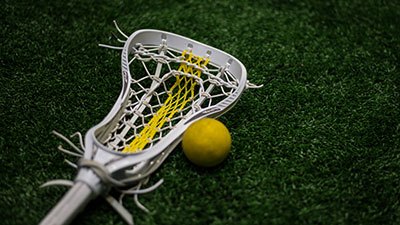
A lacrosse transition refers to passing the ball from offense to defense, or vice versa, without stopping play or committing an offensive or defensive foul.
In men's lacrosse, any player of either team can transition the ball when it is on the ground. Women's lacrosse understandably allows for less physicality and contact. Transitioning the ball is only permitted when possession has been established by the offense and a whistle has been sounded by the referee.
All players on both sides can then participate in a five-second "transition procedure" that involves no kicking, throwing, or carrying. They must instead slide, roll or pass the ball. A goal cannot be scored directly from a transition, as well. Only once play continues after successful transitioning can a shot attempt be made.
Transitions provide teams with an efficient way to rotate players between offense and defense without sacrificing speed and are key components of playing effective lacrosse.
Frequently Asked Questions
What are the 10 players in lacrosse?
The ten players include:
- three offensive players - attackers
- three defense players - long poles
- three midfielders
- one goalie.
What is the most aggressive position in lacrosse?
The most aggressive lacrosse position is defense. Defense players do not have advanced stick skills. However, they are the most aggressive players to stop the opponent's offense from scoring.
What are the offensive positions in lacrosse?
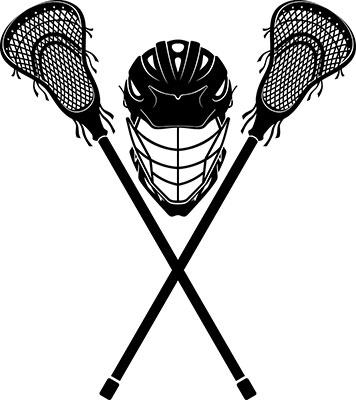
The offensive positions in lacrosse include the attackers in men's lacrosse, while the first home, second home, and attackers are the offense in women's lacrosse.
What is the most athletic position in lacrosse?
The most athletic position in lacrosse is the midfielder. These players must run on the whole field and play both offense and defense.
What position runs the most in lacrosse?
Midfielders run the most, as they cover all parts of the field.
How to choose your spot on the lacrosse field?
To choose a proper spot, you should consult your coach or other experts to determine your skills and possibilities. For example, if you cannot cope with the stick but you are more aggressive, then you might play defense.
On the other hand, if you can run fast and assist both types of players, you can play midfield.
If you have advanced stick skills, are sharp, and are focused on the goal, you can play the offense/attacker.
Finally, if your abilities best cover the protection of the goal, and you can quickly catch even the fastest balls, you are suitable for a goalie position. Remember that this is the hardest position to play in lacrosse.
What are the positions in box lacrosse?
There are four positions in box lacrosse: forwards, defensemen, transition players, and goalkeepers.
Conclusion
There are many different positions in lacrosse, each with its unique responsibilities. While it may seem daunting at first, try out each position to see which one you work best in.
You might be surprised at how well you fit into a specific role you would never have thought of. Experiment and find the perfect position for you to excel in the lacrosse field.
